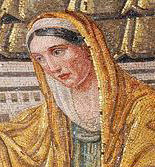
Saint Claudia may refer to:
- A Christian of 1st-century Rome, mentioned by Paul alongside Eubulus, Pudens and Linus in his Second Epistle to Timothy 4:21. [1] Nothing is known of her origins or social or marital status, which has led to centuries of speculation, such as that she was: [2]

Saint Pudens was an early Christian saint and martyr.

Pope Saint Linus was the second Bishop of Rome and Supreme Pontiff (Pope) of the Catholic Church.

In the New Testament, the Second Epistle of Paul to Timothy, usually referred to simply as Second Timothy and often written 2 Timothy or II Timothy, is one of the three pastoral epistles traditionally attributed to Paul the Apostle. The three epistles are called "pastoral" because they relate to the conduct of church leaders, thought of as pastors. It is traditionally considered to be the last epistle he wrote before his death. It is addressed to Timothy, a fellow missionary.
- The mother of Linus. According to the 4th-century Apostolic Constitutions , he was the first bishop of Rome, ordained by Paul and his mother was named Claudia. [2]
- Claudia Rufina, a 1st-century British woman living in Rome, wife of Aulus Pudens. Since the 19th century she and her husband have been identified by some as the Claudia and Pudens of Second Timothy. She is usually identified as a daughter either of Cogidubnus or Caractacus. She is mentioned by Martial, but there is no direct evidence she was even a Christian. [1]
The Apostolic Constitutions or Constitutions of the Holy Apostles is a Christian collection of eight treatises which belongs to the Church Orders, a genre of early Christian literature, that offered authoritative "apostolic" prescriptions on moral conduct, liturgy and Church organization. The work can be dated from 375 to 380 AD. The provenance is usually regarded as Syria, probably Antioch. The author is unknown, even if since James Ussher it was considered to be the same author of the letters of Pseudo-Ignatius, perhaps the 4th-century Eunomian bishop Julian of Cilicia.
Claudia Rufina was a woman of British descent who lived in Rome c. 90 AD and was known to the poet Martial. Martial refers to her in Epigrams XI:53, describing her as "caeruleis [...] Britannis edita". He praises her for her beauty, education and fertility.
Aulus Pudens was a native of Umbria and a centurion in the Roman army in the late 1st century. He was a friend of the poet Martial, who addressed several of his Epigrams to him. He has been identified by some with Saint Pudens, an early Roman Christian.
- Two martyrs from the Diocletianic persecutions:
- One of the virgin martyrs of Amisos, burnt at the stake around 300. Their names were Claudia, Alexandra, Euphrasia, Matrona, Juliana, Euphemia, Theodosia and Derphuta with her sister. Their feast day is March 20. [3]
- One of the companions of Theodotus of Ancyra, martyred probably in 303. The other victims were Theodotus' aunt Thecusa and six virgins named Alexandra, Claudia, Phaina, Euphrasia, Matrona and Julitta. The virgins were raped and then drowned in a marsh. Their feast day is May 18. [4]

Saint Theodotus of Ancyra was a fourth-century Christian martyr.






